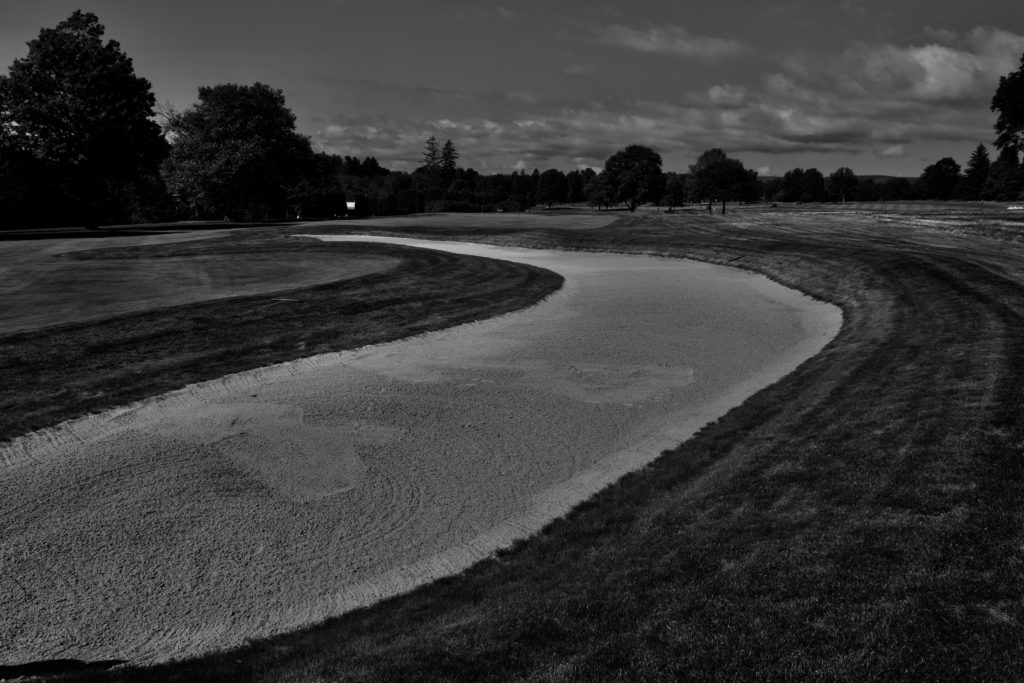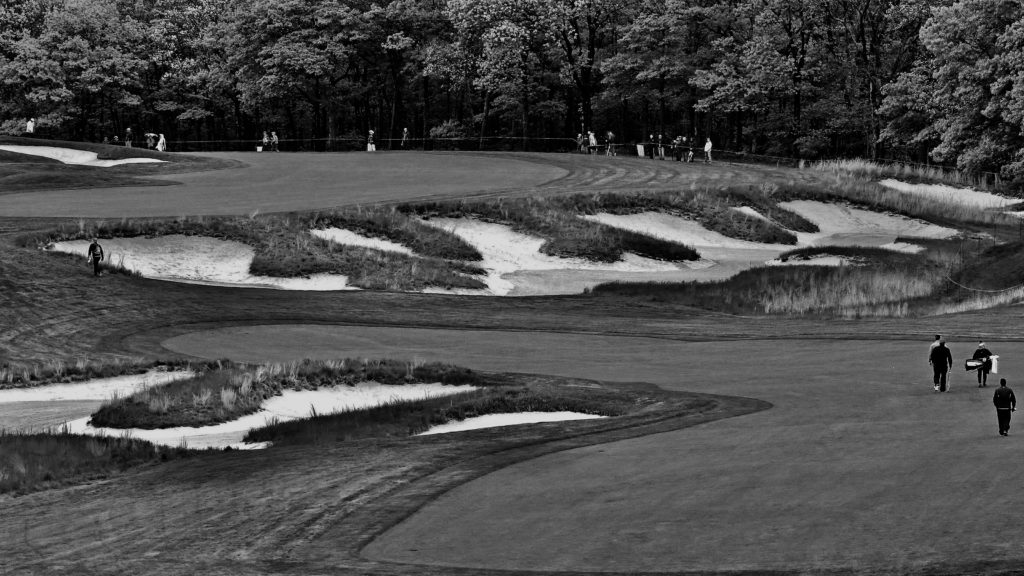“I have known Charley Macdonald since the earliest days of golf in this country and for many years we have been rival course architects, and I really mean rivals for in many instances we widely disagreed. Our matter of designing courses never reconciled. I stubbornly insisted on following natural suggestions of terrain, creating new types of holes as suggested by Nature, even when resorting to artificial methods of construction. Charley, equally convinced that working strictly to models was best, turned out some famous courses. Throughout the years we argued good-naturedly about it.”
If you were to take A.W. Tillinghast’s word for it, the Golden Age of Golf Course Architecture was broken into two camps: those using templates, and those going without. There’s a kernel of truth to this…and plenty untrue as well. Tillie, for all his hay about the “natural suggestions of terrain,” frequently turned to templates. Tillinghast went as far as developing his own portfolio of templates. There are four, and this series will shed some light on these “lesser templates,” typically ignored in today’s conversations on the subject of designed holes.
Today’s is most definitely the least-recognized of Tillinghast’s templates…perhaps because it often appears to simply be quality course architecture. The majority of his templates are instantly recognizable: The “Great Hazard,” of course, has an obvious great hazard, and the greens on a “Tiny Tim” stand out for their ring of defense. Technically today’s template also has an easily-identified feature built right into its name…but it’s not as glitzy as the phrase “Great Hazard.”
And so we examine Tillinghast’s “Double Dogleg.”
THE BIG IDEA
Tillinghast was a noted golf writer during his day, so we turn to a 1926 entry in Golf Illustrated for Tillie’s claim to the Double Dogleg. He does so quite simply: “Probably 15 years ago I originated the double dog-leg for a plan of a three-shot hole.”
Most golf architecture aficionados will instantly understand the appeal of a double dogleg. Simply put: A hole that doglegs twice requires multiple skills on behalf of a golfer in order to optimize their performance during the hole. So, for example, a fade may behoove the player from the tee, but they’ll be required to execute a draw on the next shot to create the best final approach to the green.
By this point in history, improved ball construction—and an increased uptake in the game—was making distance a poor defense. Tillinghast and others realized that, with the absence of strong bunkering, straight holes were no match for sluggers. Doglegs are a largely American development, and almost immediately drew reproach from some golfers, who didn’t feel like thinking during a round. From a 1902 article in Illustrated: “This hole has been criticised by some on the ground that the player cannot play straight for the hole.” Well, duh. Considering the complaints from players, you can assume correctly that Tillinghast embraced the idea wholeheartedly.
A dogleg wasn’t the only tool available for upping the challenge of a hole, however. Although most Golden Architects leaned on this method at least somewhat, Donald Ross in particular became associated with “switchbacks,” or holes (generally Par 4s) requiring the two different shots as described above.
Tillinghast’s Double Dogleg combines the then-novel dogleg concept with switchback theory for a Par 5 of some skill.

THE ORIGINAL
Based upon Tillinghast’s passage above, there aren’t too many courses to choose from in gauging where he “originated” the idea. He was young to the design game circa 1910, and sure enough his very first original design—Shawnee Inn and Country Club, situated on the Delaware River in northeast Pennsylvania—shows a fine example of this concept in motion.
We were unable to find an original scorecard, but it’s fair to assume Shawnee originally played just a bit shorter than its current 6,800 yards at the time of its opening. No. 13, now the no. 1 handicap hole at 570 yards is—and always has been—a three-shot Par 5. The shot from the tee will (or should) fade right toward a relatively undefended dogleg, while the second shot will draw left, over a large fairway bunker and presumably settle before a large centerline bunker, which squeezes the fairway down. Both shots, however, come with some degree of questioning. Although there’s little defense against attacking the first dogleg, landing in the rough will complicate the second shot, and there is plenty of fairway left from the tee. The second shot, into the second dogleg, is more perplexing because of the large bunker that fronts the landing area. The ideal shot—180 to 200 yards—flies over the hazard to a landing area, which the bunker blinds. A conservative player may simply hit a straight second shot and stay left of the trap…but this tactic means the final approach will be obscured by the centerline bunker).
There are some mild comparison points for the Double Dogleg among links courses. Perhaps the most compelling is “Foxy,” No. 14 at Royal Dornoch. Although not a Par 5, its 445-yard length makes it a Par 4.5 for most match players. It doglegs slightly left off of the tee, and then back again toward a green tucked right, above a dune. If it’s not a true “Double Dogleg,” it’s certainly a switchback from hell, which is probably what Tillie was after.

TWEAKS
The trick with the Double Dogleg, and whether it deserves recognition as a Tillinghast “template,” is how few he created. A rare few emerged following Shawnee.
No. 15 at Sunnehanna Country Club is a rare, clear example of the premise in motion…a 595-yard beast that still provides a challenge for participants in the annual Sunnehanna Amateur. From the tee, players will drive uphill, wanting to flirt with the fairway along the dogleg right, which are guarded by three bunkers rising in altitude along with the fairway. The second dogleg doesn’t come until immediately prior to the green, but execution is essential, as a bunker guards greenside right, and the trench at greenside left is the deepest trap on the course, almost reaching Raynorian scale.
Some are not so obvious, however. For example, consider No. 9 at San Francisco Golf Club. The course’s wide fairways occasionally hide the semblance of a dogleg, as is the case. Consider the ideal approach, however: The ideal play will fade over the first fairway bunker on the left, and then settle into the center of the fairway. From there, the best shot will behave much like the aforementioned example at Shawnee, with a draw flying over a row of three bunkers that jut into the fairway from the right. This shot will give an optimal line into the green; those who fear the line of bunkers can play to the fairway on the left, but will be left with an even more difficult draw in order to reach the green in regulation.

MODERN TAKES
Although certainly not “modern,” it’s worth noting other concurrent architects bought into the same theories regarding a double-doglegged Par 5. Between two rounds of course edits made by Donald Ross and then the William Langford/Theodore Moreau duo, Skokie Country Club emerged with two impressive Double Dogleg Par 5s, at Nos. 7 and 11. Both involve a key decision whether to travel over crossbunkers during the second shot, and the latter hole also features a brook running up its right side, which eventually becomes threatening near the green.
Tillinghast certainly claimed the Double Dogleg idea, but it’s reasonable to say that Pete Dye became the king of the concept during his career. No. 11 at TPC Sawgrass induces players to get close to a massive sand hazard, cross the water and flirt with sand again (both a deep hazard right as well as two pot bunkers punctuating the green). The Kiawah Ocean Course No, 16 weaves around several huge swathes of waste sand. Both PGA West’s Stadium Course and Whistling Straits feature a Double Dogleg at hole No. 5, and both feature ponds where Kiawah’s rendition features sand.
Tillie may have severely blurred the lines between strategic and penal golf, but Dye took that blurring to new levels, and we’re sure his predecessor would approve.

NOT GREAT HAZARDS
Tillinghast, of course, frustrates a formal definition by never firmly defining the concept to begin with, but based on his work at Shawnee and otherwise, we can assume a Double Dogleg will dogleg in separate directions between the two shots. Some have argued that a hole that doglegs “twice” in a sickle formation—Bay Hill’s No. 6, for example—is also a Double Dogleg. We disagree. This leads us to a more controversial statement than usual: No. 4 at Bethpage Black is not a true Double Dogleg. The fact that it’s also a true Great Hazard hole is no matter; template hybrids should be encouraged. Nor is it that the hole is considerably shorter than other examples. It’s that this hole requires two great draws and nary a fade; the tee shot should wrap around the large fairway bunker on the left, while the second shot—even if not attacking the green—should also cut to the fairway’s edge for the best look at the putting surface. As with all edgy opinions, we’re happy to see research that suggests otherwise.
One more Tillie Template to go, and it’s a short one…kind of. Stay tuned for round four.